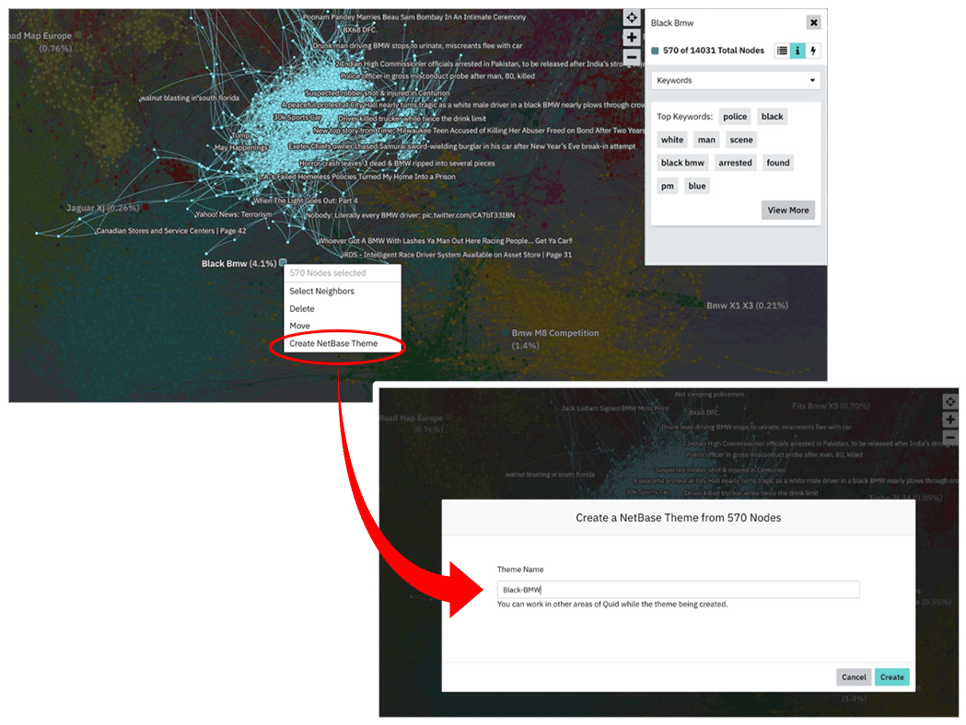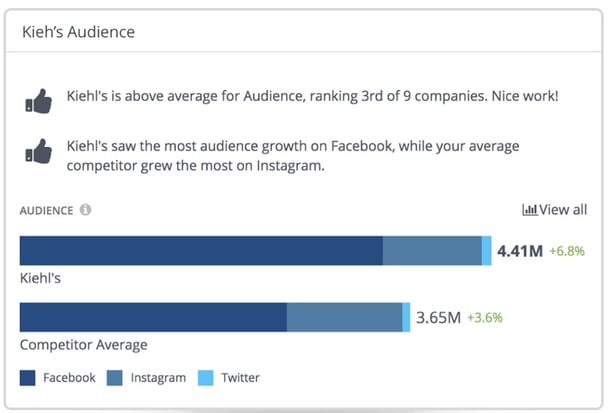Evamarie J
.png?width=1920&name=2023.Q4%20-%20Blog%20Banners%20-%20Legacy%20Blogs%20(6).png)
[Introduction to the Blog Summary]
This blog delves into the importance of customer insights for businesses, explaining how to gather, analyze, and apply these insights to enhance strategic decision-making and improve overall performance.
[Key Points Overview]
[Top Takeaways]
[Conclusion] Utilizing customer insights effectively allows businesses to make data-driven decisions, improve strategic planning, and enhance customer satisfaction, ultimately leading to a significant competitive advantage in the market.
When brands talk about ‘consumer insights,’ they should mean actionable intelligence derived from diverse data sources. If this isn’t how your team approaches customer insights, it may be time to rethink your strategy. Let’s break down the standards for effective customer insights and why settling for less can hold your brand back.
The process starts with collecting the right data at scale. This is essential but far from straightforward. Customer data comes from multiple sources, each offering valuable perspectives:
Why do customer insights matter? Because customers expect businesses to understand their needs and respond in real time. Insights help brands make smarter decisions—whether it’s identifying product opportunities, adapting to market changes, or improving customer experiences.
Data is only the starting point. The real challenge lies in turning raw data into meaningful outcomes that inform decisions and drive success. Brands that master this process gain an edge in today’s fast-moving, customer-driven marketplace.
Consumer insights are only as valuable as the analysis behind them. Collecting data is just the first step—true understanding comes from interpreting that data to uncover patterns, behaviors, and opportunities. Without thoughtful analysis, consumer research efforts lack direction and fail to deliver meaningful results.
The power of consumer insights lies in context. Businesses need to connect the dots between data sources, such as customer feedback, purchase behavior, and online activity, to understand what drives their audience. Social media offers a unique window into real-time consumer sentiment and trends, but it’s only part of a larger picture that includes reviews, market data, and transactional insights.
By turning raw data into actionable knowledge, businesses can make strategic decisions that drive growth, enhance customer experiences, and stay ahead of market shifts. Effective consumer insights aren’t just about understanding the “what” of consumer behavior—they’re about uncovering the “why” that informs smarter decisions.

Advances in technology and research have made it easier than ever to collect consumer data. However, while many businesses have access to vast amounts of data, the challenge lies in organizing it effectively to generate meaningful insights. With so much information available, choosing the right approach and tools is crucial for success.
Here are four key methods to gather and analyze consumer insights:
Consumer sentiment reveals how people feel about your brand, which plays a significant role in influencing purchasing decisions. Sentiment analysis helps you understand the emotions driving customer behavior, whether positive or negative, so you can take corrective action or amplify what’s working.
Sentiment analysis tools aggregate data from sources like social media, analyzing customer conversations to reveal trends in how your brand is perceived. This insight is especially valuable for monitoring shifts in sentiment over time and benchmarking your brand against competitors.

To perform customer sentiment analysis, you need a sentiment analysis tool. It takes data gathered through social listening and digests it to reveal the emotions expressed in social media posts by your customers. With Quid®, you can quickly see customer conversations as well as an aggregate sentiment score that ranks on a scale from -100 to 100. And you can compare these metrics against competitors over time, making your relative position easy to monitor and improve:

Every interaction on your website generates data that can provide valuable insights into consumer behavior. Website analytics help you understand your audience, from where they’re coming from to how they engage with your site.
Tools like Google Analytics can track metrics such as page views, bounce rates, traffic sources, and user behavior, giving you a clear picture of what’s working and what needs improvement. For ecommerce businesses, specialized tools can provide deeper insights into customer journeys and purchasing habits, helping optimize the shopping experience.
Understanding your competitors is another way to gather valuable consumer insights. By analyzing how their products, marketing strategies, and customer interactions resonate with their audience, you can identify trends and gaps in the market.
Focus on customer reviews, social media engagement, and product sales data to uncover what’s driving consumer preferences and expectations. This kind of competitive benchmarking helps ensure your offerings stay relevant and appealing in a crowded market.

Customer reviews are a rich source of direct feedback. Making it easy for customers to leave reviews—whether on your website, social media, or review platforms—can provide actionable insights into their experiences and expectations.
Using customer relationship management (CRM) software can streamline the process of collecting and analyzing feedback. Be sure to also monitor third-party review sites and forums for additional insights that might not be captured directly. These reviews often highlight areas for improvement and opportunities to exceed customer expectations.
Observational data focuses on tracking consumer actions rather than relying on self-reported feedback. This can include in-store behavior, heatmaps on websites, or app usage patterns. Tools like session replay software for websites or traffic counters in physical stores can provide insights into how customers interact with your business in real-time.
Many brands build or monitor online communities, such as forums, social media groups, or niche interest platforms, where customers actively discuss products and share experiences. These spaces offer unfiltered feedback that can reveal customer pain points, emerging trends, and opportunities to better serve your audience.
Social Listening Tools
Tools like Hootsuite, Brandwatch, and Sprout Social help monitor public conversations across major social platforms like Twitter, Instagram, and Facebook. They track mentions, hashtags, and keywords to identify recurring themes, sentiment, and trending topics related to your brand or industry.
Specialized Platforms for Forums and Communities
Tools like Quid extend beyond traditional social media by analyzing discussions in forums like Reddit, niche industry groups, and private social platforms. These tools provide actionable insights by aggregating and analyzing conversations at scale.
Community Engagement Analytics
Platforms like Discord, Slack, or even branded forums can generate valuable insights if you analyze user activity, sentiment, and frequently discussed topics. Tools like Orbit are designed specifically for tracking engagement and participation within these types of communities.
Surveying Community Members
Actively engaging with community members through polls, surveys, or feedback forms can provide direct responses tailored to specific questions. Many platforms, such as LinkedIn or Facebook Groups, have built-in features for conducting polls or hosting Q&A sessions.
AI-Powered Sentiment Analysis
Sentiment analysis tools like those offered by Quidcan assess how members feel about a particular topic or product by analyzing the tone of their posts and comments. These insights can guide decision-making on how to address concerns or capitalize on positive sentiment.
Web Crawlers and Data Scraping Tools
For monitoring open communities and public forums, tools like ParseHub or Octoparse can extract raw data for analysis. This approach requires compliance with data privacy regulations but can yield a wealth of information from unstructured sources.
Community Moderation Reports
If you operate your own community or forum, moderation tools can provide aggregated reports on flagged topics, trending conversations, or frequently asked questions. This data often highlights recurring concerns or interest areas that can guide strategic decisions.
Competitor Community Monitoring
Don’t overlook competitor communities as a source of insights. Tools like Quid can help track conversations around competitor products or campaigns, offering valuable benchmarks and highlighting opportunities for differentiation.
Monitoring online communities isn’t just about tracking conversations—it’s about understanding the deeper context and using that insight to make informed, strategic decisions. By leveraging the right tools and approaches, businesses can tap into this valuable source of consumer insights efficiently and effectively.
Consumer insights are invaluable for businesses aiming to stay competitive and responsive to their customers’ needs. How these insights are applied depends on specific goals, but here are five effective strategies to turn insights into action:
Creating buyer personas is a foundational step for understanding your audience. These profiles represent the typical customers for your products or services, including their needs, preferences, and behaviors. However, personas built on assumptions or outdated data can lead to ineffective targeting.
Consumer insights allow you to validate or refine these personas. For example, analyzing purchasing patterns, social sentiment, and customer feedback might reveal new customer segments or highlight evolving behaviors in your existing audience. With data-driven personas, you can confidently adjust marketing strategies, product development, and customer experiences to resonate with your target audience.
Additionally, insights can help you categorize your audience into niche groups, enabling hyper-focused campaigns that address specific needs. This granularity can lead to better customer engagement and higher conversion rates.
Personalized marketing relies on understanding not just who your customers are, but what drives their decisions. Consumer insights provide the foundation for crafting tailored messages and experiences that align with individual preferences.
For instance, by analyzing customer purchase histories, website interactions, and demographic data, you can deliver targeted promotions, product recommendations, or content. This goes beyond addressing customers by name—it’s about demonstrating that you truly understand their unique needs and preferences.
Personalization also extends to discovering new opportunities. For example, two distinct groups might share a common problem that your product can solve. Identifying these overlaps enables you to craft campaigns that resonate with both groups, potentially creating a new product category or expanding your reach to previously overlooked audiences.
Every market has unmet needs—gaps that represent opportunities for brands willing to listen to their customers. Consumer insights can reveal these gaps in several ways:
Consumer insights also help businesses identify emerging trends, giving them the opportunity to act early. This proactive approach allows companies to refine their offerings and capitalize on new demands, gaining market share before competitors catch on.
Product-market fit is critical to success—it’s the alignment between your product and the needs of your target audience. When achieved, it leads to high customer satisfaction, strong retention rates, and organic growth.
Consumer insights can reveal whether your product is meeting customer expectations. If there are gaps, these insights help you prioritize improvements, whether it’s addressing recurring complaints, adding features, or simplifying the user experience.
For businesses still working toward product-market fit, insights can guide product development by identifying the most pressing customer pain points. By showing customers that their feedback is being heard and acted upon, you build trust and loyalty, even as you make adjustments.
Customer satisfaction is a key driver of repeat business and loyalty, but achieving it requires a deep understanding of what your customers value most. Consumer insights can help you pinpoint the factors that influence satisfaction, such as:
Using consumer insights to address these areas allows you to anticipate and meet customer needs, fostering long-term loyalty. Satisfied customers are more likely to advocate for your brand, leave positive reviews, and recommend your products to others.
By strategically applying consumer insights, businesses can optimize their operations, strengthen their market position, and create experiences that resonate with their audience. This data-driven approach ensures decisions are grounded in real customer needs, leading to sustainable growth and competitive advantage.
As businesses collect and analyze consumer data, the next frontier lies in predictive analytics—using historical data and advanced algorithms to anticipate future consumer behaviors and market trends. Unlike traditional analysis, which focuses on what has already happened, predictive analytics empowers businesses to forecast what is likely to happen, offering a significant competitive edge.
Predictive analytics leverages large datasets, including social media activity, purchasing behavior, and review sentiment, to identify patterns and correlations. Advanced models, often powered by artificial intelligence, process this data to predict outcomes such as:
The ability to anticipate customer needs allows businesses to act proactively rather than reactively. For example:
Dynamic Personalization: Predictive insights can enhance personalization by anticipating customer preferences and tailoring recommendations or offers in real time. For example, an ecommerce platform might recommend products based on browsing history combined with trending preferences in the customer’s demographic.
Customer Retention Programs: Businesses can use predictive models to identify at-risk customers and implement targeted retention strategies, such as loyalty programs or personalized outreach, to re-engage them.
Innovation and Product Development: Predictive consumer analytics informs R&D by identifying unmet needs and forecasting demand for potential solutions. This helps businesses invest in the right innovations at the right time.
Competitor Strategy: Predictive insights also extend to competitive analysis, helping brands anticipate rivals’ next moves and stay a step ahead in the market.
While predictive analytics is powerful, it’s not without challenges. Successful implementation requires:
Predictive customer analytics represents a transformative step in leveraging consumer insights. It equips businesses with the foresight to make smarter decisions, seize opportunities, and mitigate risks—all while staying aligned with evolving customer needs. As this technology becomes more accessible, businesses that embrace predictive analytics will be better positioned to thrive in an increasingly dynamic and data-driven marketplace.
Quid is designed to help businesses unlock the full potential of consumer insights by combining advanced AI technology with powerful data models. By analyzing billions of data points across social media, market data, reviews, and behavioral signals, Quid delivers actionable intelligence tailored to your unique goals. Whether you’re refining buyer personas, identifying emerging trends, optimizing product-market fit, or enhancing customer satisfaction, Quid’s tools provide the clarity and context needed to make data-driven decisions.
With Quid, insights go beyond surface-level metrics to reveal the underlying “why” behind consumer behaviors. This empowers businesses to stay ahead of the curve, meet evolving customer demands, and achieve measurable outcomes. By leveraging Quid’s cutting-edge capabilities, you gain a comprehensive, real-time understanding of your market, ensuring your strategies are not only informed but impactful.